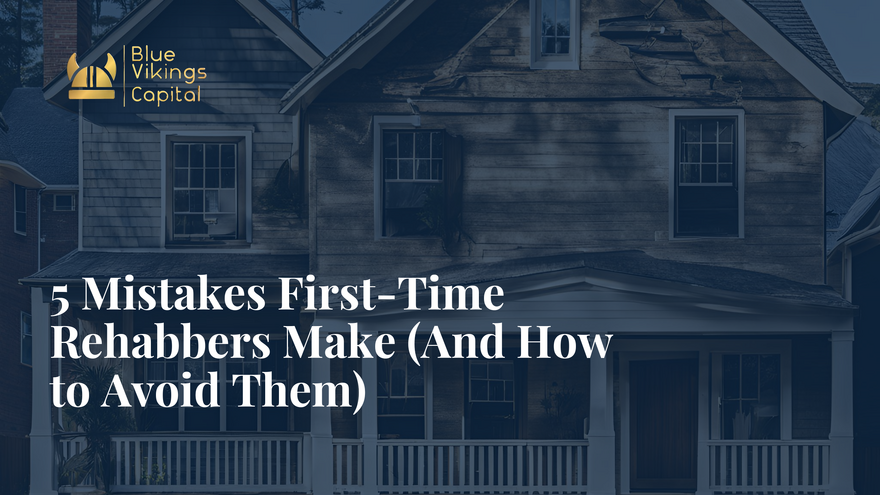5 Mistakes First-Time Rehabbers Make (And How to Avoid Them)

Rehabbing properties can be a lucrative venture, but for first-time investors, it’s a path laden with potential pitfalls. A single misstep can mean the difference between a successful flip and a financial loss. By learning from common mistakes, first-time rehabbers can maximize their profits and minimize their risks. Below, we explore five mistakes that novice rehabbers often make and provide actionable strategies to avoid them.
1. Failing to Budget Properly
One of the most significant errors first-time rehabbers make is underestimating the costs associated with a project. It's easy to overlook hidden expenses such as permits, unforeseen repairs, holding costs, and closing fees. Inadequate budgeting often leads to stalled projects or reduced profits.
How to Avoid It:
- Create a Detailed Budget: Include costs for acquisition, renovation, holding, and unexpected contingencies (usually 10-15% of the total project cost).
- Get Multiple Estimates: Obtain quotes from several contractors to ensure accuracy in renovation cost estimates.
- Research Local Market Data: Understand property values and neighborhood-specific costs to avoid over-investing in upgrades that won’t yield returns.
Source: National Association of Home Builders (NAHB) suggests factoring in a contingency buffer of at least 10% for unforeseen costs.
2. Overestimating the After Repair Value (ARV)
Overconfidence in a property's potential resale price can derail profitability. First-time rehabbers often set unrealistic expectations for what buyers are willing to pay post-renovation, resulting in an extended selling timeline or financial loss.
How to Avoid It:
- Use Comparable Sales (Comps): Analyze recently sold properties in the same neighborhood with similar features.
- Work with Experts: Partner with a real estate agent experienced in the local market.
- Be Conservative: When calculating ARV, err on the side of caution to protect against market fluctuations.
Source: The Federal Housing Finance Agency provides online tools to check historical and current property trends.
3. Cutting Corners on Renovations
In an attempt to save money, some first-time rehabbers opt for subpar materials or unlicensed contractors. While this might reduce upfront costs, it often results in lower quality, buyer dissatisfaction, or even legal issues.
How to Avoid It:
- Invest in Quality: Focus on improvements that deliver the best return on investment, such as kitchen updates, bathrooms, and curb appeal.
- Hire Licensed Professionals: Work only with vetted, licensed, and insured contractors to ensure compliance with local building codes.
- Inspect Work Regularly: Conduct site visits to monitor progress and quality of workmanship.
Source: According to Remodeling Magazine's Cost vs. Value Report, high-quality kitchen and bathroom remodels offer the best ROI.
4. Ignoring the Timeline
Time is money in real estate. The longer a property sits on the market or the more delays occur during renovations, the higher the holding costs (e.g., mortgage payments, taxes, utilities). First-time rehabbers often underestimate how quickly projects can spiral out of control.
How to Avoid It:
- Set a Realistic Timeline: Account for permits, inspections, and potential delays.
- Stick to the Schedule: Avoid changing plans mid-renovation unless absolutely necessary.
- Secure Reliable Funding: Work with lenders like Blue Vikings Capital, which offers fast approvals and flexible terms tailored to rehabbers.
Source: A study by Realtor.com shows that properties staying on the market for over 60 days often experience price reductions, cutting into profits.
5. Choosing the Wrong Property
Not all properties are created equal, and many first-time rehabbers fall into the trap of purchasing homes with fundamental issues—such as poor location, structural damage, or over-leveraged pricing—that drastically reduce profitability.
How to Avoid It:
- Focus on Location: Properties in desirable neighborhoods sell faster and at higher prices.
- Conduct Thorough Inspections: Identify major repair needs (e.g., roofing, foundation, plumbing) before making an offer.
- Stick to the Numbers: Ensure the property fits the 70% ARV rule: purchase and renovation costs combined should not exceed 70% of the after-repair value.
Source: BiggerPockets emphasizes using the 70% rule as a baseline for evaluating potential flips.
Rehabbing properties can be an exciting and profitable journey, but it requires careful planning and execution. By avoiding these common mistakes—budget mismanagement, overestimating ARV, cutting renovation corners, neglecting timelines, and selecting unsuitable properties—first-time rehabbers can set themselves up for success.
Partnering with a lender that understands your goals, like Blue Vikings Capital, ensures you have the financial support to tackle challenges confidently and achieve your vision. Start with small, manageable projects, and grow your portfolio with each successful flip.
Blue Vikings Capital offers free resources for Rehab Projects. Download our free Rehab Planning Guide, complete with a Scope of Work and Budget Template, plus a Renovation Timeline/Calendar. For more tips or to explore funding options, visit Blue Vikings Capital.


0 comments
Leave a comment
Please log in or register to post a comment